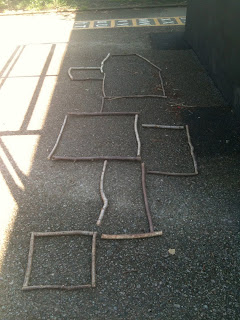The sticks are getting a serious amount of use at the moment. Last week I used them for an activity in a P5-7 class to reinforce the language of shape. This is what happened:
The children had to get into groups of 4 and take 12 large and 12 small sticks. The challenge was to make a shape or picture that contained the most shapes possible.
Some groups decided that a picture would work best. In the photo below if you turn your head, you’ll see a tractor with a trailer…

Another group opted to make a rocket. I had to take the photos at odd angles, owing to the sunlight…

One child needed to work on his own. He used a few sticks donated from the rocket group and another group and was happy to experiment with different geometric shapes on his own…

The geometric shapes seemed to work in terms of looking at shapes within shapes…

This initially took some practice, but the group that created the shape below had lots of discussions about the number of trapeziums within their shape…

The challenge didn’t end here. On a wall I had put some suggested letters and symbols. Using chalk, the groups had to identify through colours and the codes, the different attributes. This was a great way to reinforce these concepts.

The boy with his own shape, made a right angle detector to check the angles…

What interested me was that the children did not seem perturbed by the odd curve and knobble in the sticks.

The chalk marks left an interesting reminder of the activity once the sticks had been tidied away.
If I was doing this activity again, I’d use counters such as multi-link cubes or natural materials such as shells instead of chalk to highlight the angles, etc. Many playgrounds eat up chalk and so it’s not economical. What variations would you make to this activity?




















Good old sticks – where would we be without them 😉 I’m just about to post about an obstacle course our kids made themselves consisting mostly of sticks – they were so absorbed, so busy and working so well together – and so very proud when they were done.
Ahh the humble stick, much like a cardboard box really, are the best playthings. J adores sticks. Hmmm think he could manage a simplified version of this 🙂
Will you come by and share on our outdoor play link-up? 🙂
This is wonderful – I am going to start collecting sticks over the summer. I do live in the woods so it shouldn’t take me long:)
Hi Jenny – yes it’s interesting to see what children do when just left with a pile of sticks. Very often the lightsabers quickly become something else..!
Kate – my apologies about not managing the link ups so far. I’ve just been worked off my feet and need to make an effort here! I find just letting younger children make pictures with the sticks works well. If they make an outline shape then it can be fun to estimate how many children can fit inside the shape!
I use a mix of cut and gathered sticks. These sticks in this post come in 30 and 60cm lengths and are handy for geometric pattern and shape work. Bamboo canes would be fine for this purpose too, but they don’t feel quite as aesthetically pleasing to use.
Juliet I love, love, love, love, LOVE this post! Now every child can have their sticks and play with them too … There is NO excuse for teachers to ban them when they can encourage this kind of play!!!
Donna 🙂 🙂
I find asking children to create rules and expectations around stick use helps reduce inappropriate behaviours. I’m quick to confiscate any stick that’s being misused and generally the children are incredibly sensible.
What a fantastic idea! After a week of assessments, I’m looking for something outdoors, creative and collaborative without wanting to sacrifice too much literacy or maths and this is perfect!
I do love this, Juliet. Such a simple idea but full of fun and learning.
I do strongly believe that many aspects of literacy and maths can be effectively taught outdoors. I’m finding that a lot of the activities take the stress of “marking” out of the situation. The quality of feedback and discussions tends to be better as a result. As a teacher I can more easily assess who has grasped what concepts.
I’m not quite ready to say “ditch the textbook” but I’m getting there!
I had a P1 child teaching himself the concept of conservation of measure using sticks and . . he ended up with a perfect octagon (copying the P2 children in the same group).
This child cannot read a word yet, is normally disruptive in class and has a concentration span of a flea . . but 45 minutes of peace space and pleasure and the chance to learn like this in forest school brought him on some 3 months . . .
Hi Cecilia
Children often mention how much they appreciate the freedom and space when outdoors. Also I like the fact that children get immediate feedback about their work.
This was undertaken in a playground – even this seems to be positive in terms of children being able to find space and peace, most of the time.
Thanks for your comment
Juliet